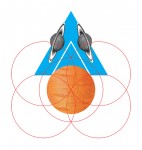 A frequently cited principle of forecasting is to look back twice as far as one looks forward. Today follows yesterday, and tomorrow today. As anyone working on innovation and change knows all too well, engagements with the future cannot avoid encounters with the past.
A frequently cited principle of forecasting is to look back twice as far as one looks forward. Today follows yesterday, and tomorrow today. As anyone working on innovation and change knows all too well, engagements with the future cannot avoid encounters with the past.
Let’s take a look at past and future through the lens of that iconic and ubiquitous foresight tool: the 2×2 scenario-planning matrix. The 2×2 was famously used at Royal Dutch Shell in the 1970s as one approach for speculating on a changing oil industry environment, and again in South Africa at the 1991-92 Mont Fleur gatherings as part of a process to enable trust-building among diverse community and national leaders. After these experiments, its use was propagated by the consulting firm Global Business Network. These days, the 2×2 is featured in popular innovation toolkits such as Business Model Generation: A Handbook for Visionaries, Game Changers, and Challengers and 101 Design Methods: A Structured Approach for Driving Innovation in Your Organization.
The standard 2×2 scenario process goes like this. Identify an issue of concern and a time frame for discussion. List the external forces or drivers that are anticipated to be of influence on this issue. Synthesize from among these driving forces two that are most salient, significant and uncertain. Express this uncertainty in the form of a yes-no, hot-cold duality. For example, big or small government, strong or weak economy, centralized versus decentralized decision making, abundant versus scarce resources, greater or lesser climate-change impacts, and so on. Plot these two forces against each other as axes on a graph to create four quadrants, each representing a scenario. Develop narratives for the four scenarios. Against these scenarios, examine current strategies and develop alternatives.
If the narratives are compelling and their titles are evocative—“Star Trek,” “Mad Max,” “World Government,” “Ecotopia”—they will steal all the attention.
Some images of 2×2 scenario matrices go so far as to show only the four quadrants and narrative titles, without actually labeling the axes. But it’s the axes that hold all the power. And how we think and feel about these forces is the key.
The 2×2, like all tools, imposes its own logic. Recall the 1960s McLuhanesque aphorism: “We shape our tools and thereafter our tools shape us.” In colloquial terms, the person with a hammer sees only nails. Our vehicles shape our understandings of mobility. Our linguistic and digital interfaces shape the ways we communicate and interact. How then might the standard 2×2 scenario process shape our perceptions of the future?
One explicit 2×2 design logic is its dualism, its arrangement of driving forces into this-or-that oppositions. If an essential competency for our times is the ability to engage in complex, this-yet-also-that challenges—and I believe it is— then the 2×2 reinforces a counterproductive set of metaphors and assumptions.
Moreover, the design logic of the standard 2×2 process is reactive. In a 2×2 world, the driving forces are presumed to be external, beyond influence. Whether this is considered a feature or a bug depends on one’s perspective.
For a company that just wants to sell the same product again, in the same way as before—say, maybe, Royal Dutch Shell—the 2×2 makes sense as a tool for reacting to potential developments in the external operating environment. But here’s the crux. Are the driving forces of government, economy, the abundance or scarcity of resources, the impacts of climate change, and so on really external to the operations of Royal Dutch Shell? Or does the company play a role in creating a future that it wants?
Now consider other organizations, in other situations. A business that thrives on disruptive innovation. Or a business that seeks to be more socially responsible. Or a nonprofit or philanthropic foundation that seeks to affect systemic change. Or a network or community that wants to explore opportunities for collaboration. Or a town that wants to explore new models of economic development. Or a governmental agency or office that is considering transformative investments or policies. Or any organization working in any field where yesterday’s business models no longer look viable.
These days, these situations are not outliers. And these organizations will find that being reactive to future changes is not good enough. What tools might supplement or replace the 2×2? I mentioned two collections of them above: Business Model Generation and 101 Design Methods. These types of books offer hints at what other scenario processes might look like. Combining futures, systems and design thinking, we can create hybrid scenario processes that meld scientific rigor with design creativity. These hybrid processes can better help governments, businesses, nonprofits, foundations, networks and communities explore plausible and desirable pathways to change.
The future that anyone wants won’t just happen. It won’t be business-as-usual. And the forces driving that future are not wholly external, not beyond influence. Organizations of all kinds can actively map out scenarios for innovation and change—scenarios that open new possibilities for creating a better tomorrow, starting with today.
Howard Silverman is partner in the scenarios consultancy Pattern Labs.
Illustration by Jasmine Silver.



